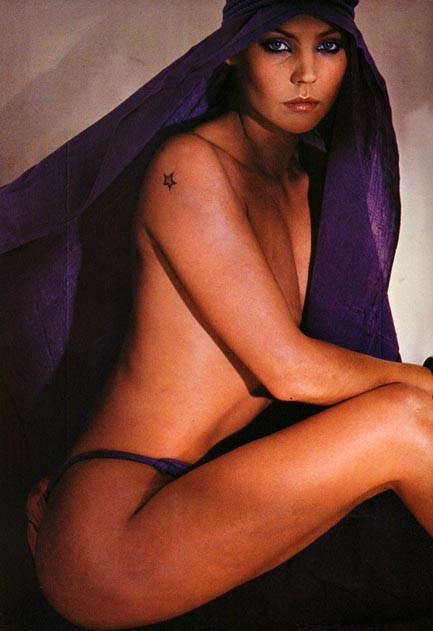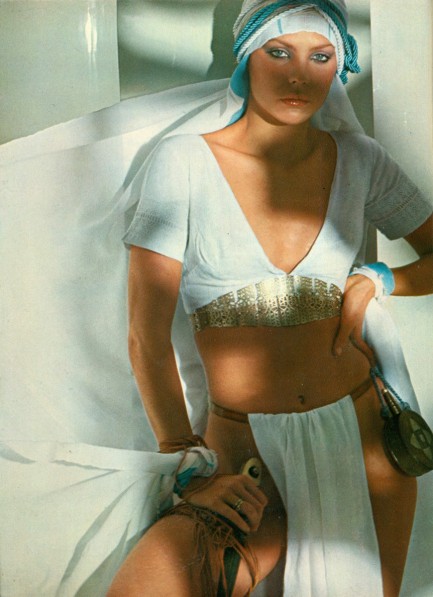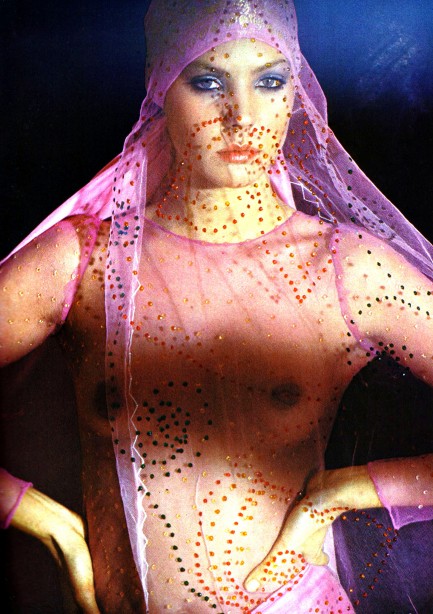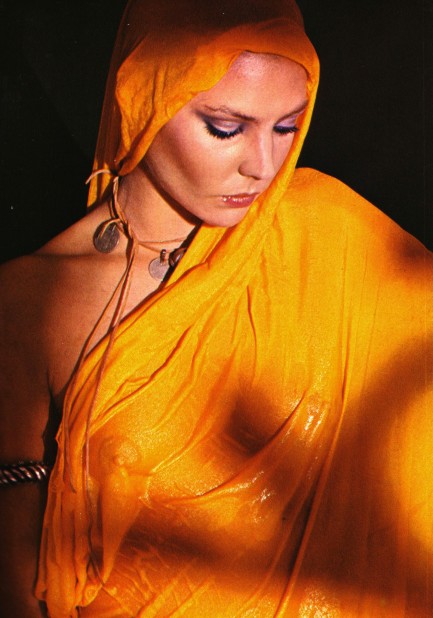 The long and short of legwear. 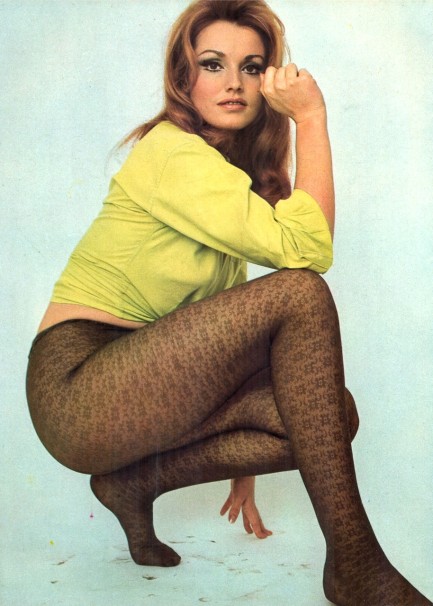 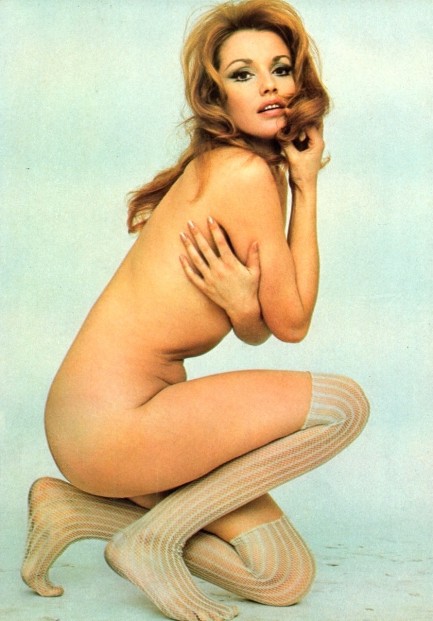
Polish actress Magda Konopka tries two different styles of leg coverage in these images that first showed up in the Italian magazine Playmen in 1967. Somewhere in the changing room she lost her shirt, but that'll happen. It's happened to us. Konopka is known for such b-movies as Blindman, Robinson and His Tempestuous Slaves, and When Dinosaurs Ruled the Earth (which we've written about to a ridiculous extent), but is probably best remembered for the 1968 thriller Satanik. We haven't watched that, but it's on the list. You can see more Konopka here.
 If she were a poker hand she would definitely be a straight flush 
Above is a sweaty photo of Swedish actress Ewa Aulin, which immediately brings to mind the saunas they love up there in Nordic countries. In fact, just a few days ago in Sweden a cop was in a sauna, noticed a wanted fugitive having a steam nearby, and apprehended him while they were both naked. True story. We learned about saunas ourselves when we wandered through Finland, though in deference to us our Finnish acquaintances wore towels. But we digress. We were talking about Aulin. She made about fifteen films, the best known of which is probably the 1968 sex comedy Candy, a flop when it was released that has garnered a cult following in recent years. Apparently it's about a woman searching for the meaning of life. We haven't watched it but we may check it out at some point. If so, we'll report back. The great photo at top first appeared in Playmen magazine in 1973, and was part of a set that included the two shots below. And as you can see, when Aulin goes all-in she does it sans towel, in deference to nobody.  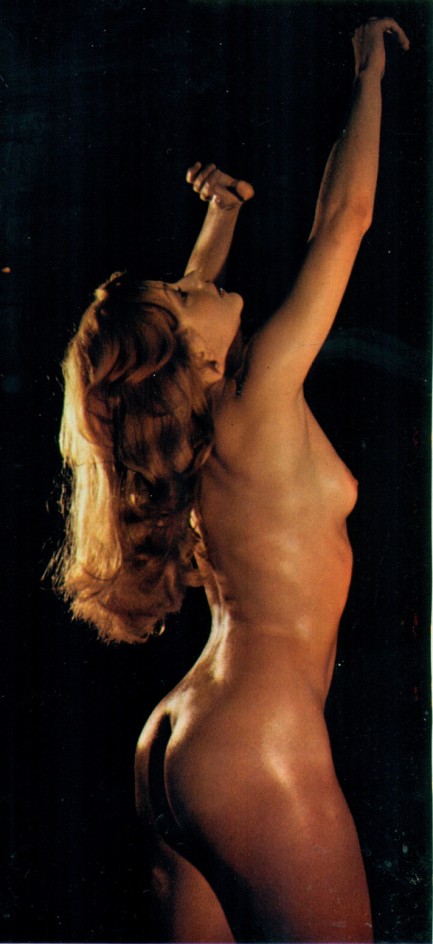
 No crown needed. 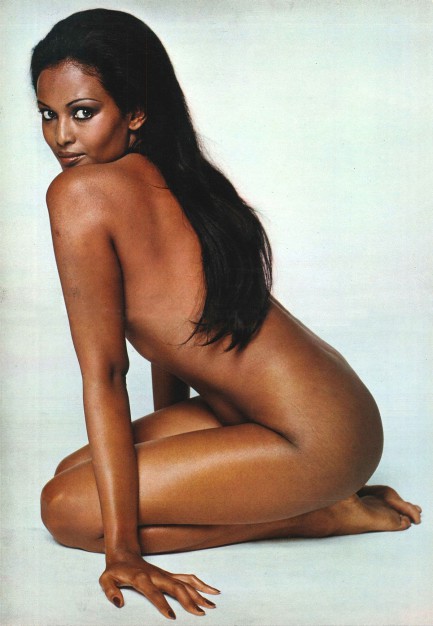
Actress Zeudi Araya was born in Asmara, Eritrea, was crowned Miss Eritrea in 1968, and used the recognition to launch a film career in Italy in 1973. She appeared in about a dozen movies, released a few records, posed for numerous magazines, including Playboy, and most recently shifted into movie production. This tasteful shot appeared in the Italian magazine Playmen and dates from 1976.
 If there’s such a thing as the most amazing dress ever made, Carroll Baker wore it. 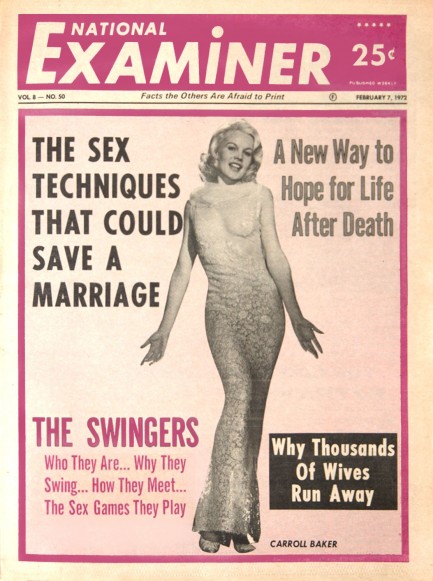
In the summer of 1964, promoting her movie The Carpetbaggers, American actress Carroll Baker attended a premiere at London’s Plaza Theatre in Piccadilly Circus wearing a $28,000.00 transparent dress from designer Pierre Balmain. She had worn it before at the U.S. premiere in June, which means Londoners had an inkling what they were going to see, but what resulted was, well, a circus. The crowd went nuts and the situation devolved into what some newspapers described as a near riot. The above National Examiner, published today in 1972, features Baker wearing what we noticed was a similar but not identical dress. We got curious where it came from, and so we went looking. Turns out in late 1964 designer Oleg Cassini, entranced by the Balmain dress, designed a similar version for Baker to wear at a promotional event in Las Vegas. The difference is in the placement of the beading—Balmain’s left a v-shaped peek-a-boo, whereas Cassini’s left a diagonal opening across the chest. You can see the difference below. Cassini had built his version of the dress in Baker’s absence using a model of identical size, but it didn’t really fit because bodies have all sorts of differences, even if their crude numerical aspects are ostensibly the same. Baker endured eighteen precarious hours in a gown that was so tight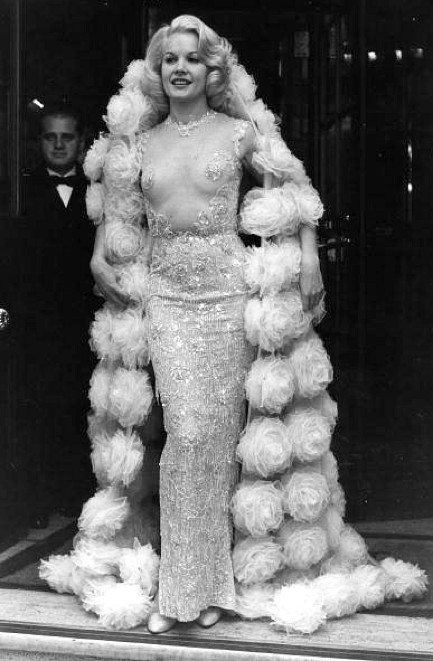 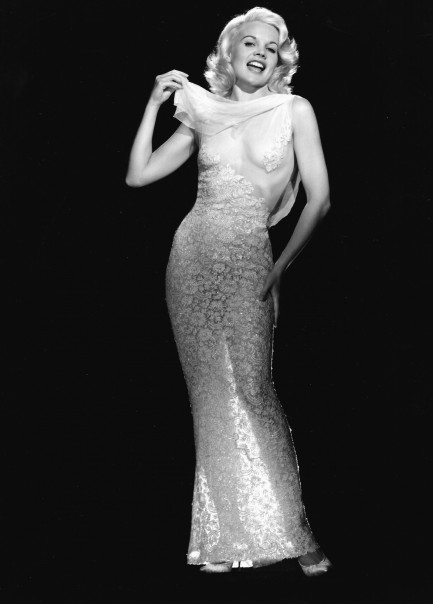 she couldn’t shake hands without it shifting to reveal parts she wanted to keep hidden. She later wore the dress—hopefully altered—at a premiere of Cheyenne Autumn, and a photo of her posing with a dozen costumed Native Americans survives today in the Associated Press archives. she couldn’t shake hands without it shifting to reveal parts she wanted to keep hidden. She later wore the dress—hopefully altered—at a premiere of Cheyenne Autumn, and a photo of her posing with a dozen costumed Native Americans survives today in the Associated Press archives. But the dress wasn’t finished quite yet. The next year immortal costumer Edith Head designed yet another variation on Balmain’s original for Baker to wear promoting the film Harlow. We don’t know where the previous two gowns went, but the Head version, one of several she put together, survived and has appeared in Hollywood fashion exhibitions as recently as 2003. Baker also wore a Balmain (or Cassini or Edith Head copy) during a 1966 troop tour in Vietnam, and the only reason a full firefight didn’t break out among the GIs the moment she unveiled herself is probably because that version had no cut-outs (right). recently as 2003. Baker also wore a Balmain (or Cassini or Edith Head copy) during a 1966 troop tour in Vietnam, and the only reason a full firefight didn’t break out among the GIs the moment she unveiled herself is probably because that version had no cut-outs (right). Extreme publicity stunts were apparently not unusual for Baker. She considered herself a good actress, but felt that she couldn’t become a star in Hollywood without promoting herself as a sex symbol. “I’ve tried just acting,” she once said, “but sex sells at the box office.” As time wore on, she went from threatening to walk off the set of Station Six—Sahara due to the director pressuring her to appear nude to playing unclothed roles in The Sweet Body of Deborah, Così dolce... così perversa, and Paranoia, as well appearing nude in Playboy and Playmen. Nothing like a shrinking bank account to totally reshape one’s morals. In 1966 AP scribe Doris Klein wrote that Baker was “almost too pretty, too much like a slim teenager to play a sexpot.” But Baker became one of the biggest sexpots in the world. Looking at the 1964 Balmain, and the three to six versions that followed, we’d say it was inevitable. 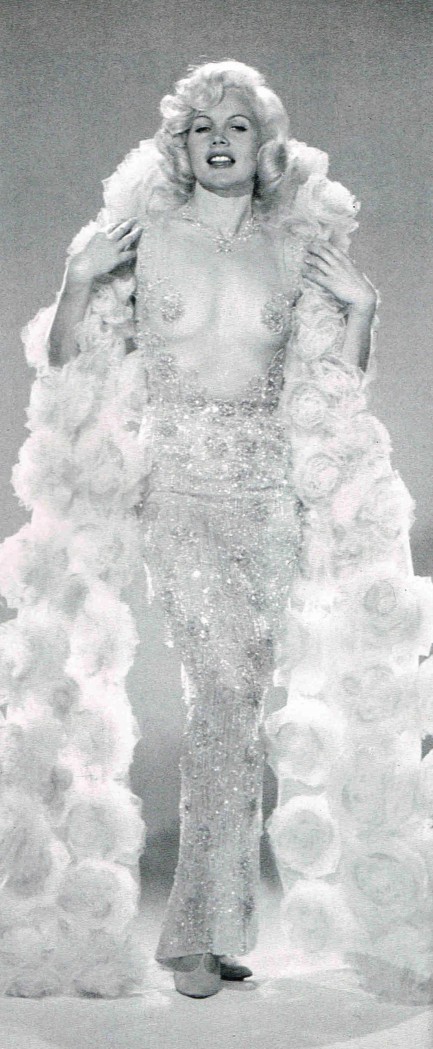 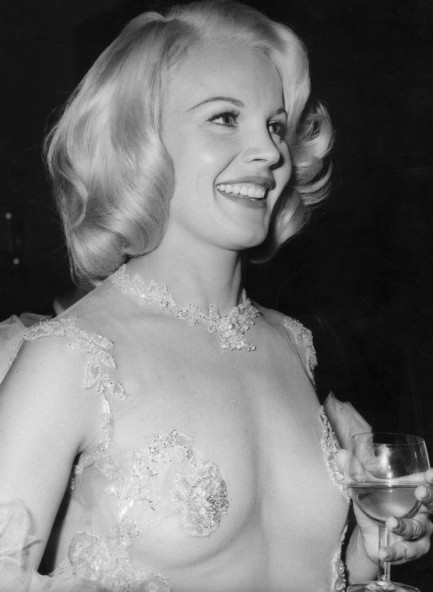
 The Tyrant has no clothes. 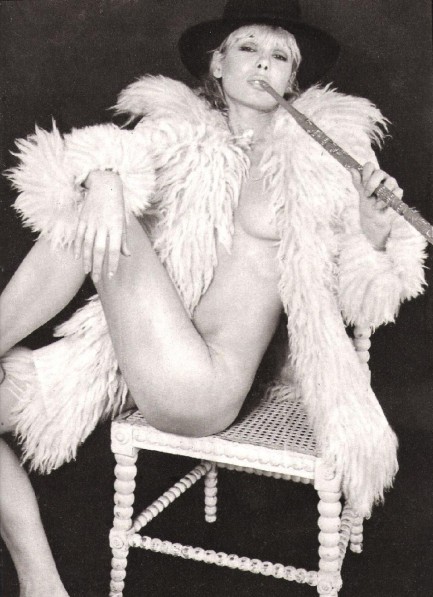
Today, nudie mags seem to be the last refuge of women whose careers are failing, but back in the day such publications were instrumental in launching careers. This photo of Italian actress Anita Pallenberg appeared in the Italian nudie mag Playmen in 1965, two years before she scored her first film role, and three years before her iconic turn as The Great Tyrant in the cult classic Barbarella. Other women who used Playmen as a stepping stone to stardom include Brigitte Bardot, Patty Pravo, Ornella Muti, and Barbara Bouchet. Pallenberg, in addition to acting, became a famous companion to Keith Richards and moved briefly into fashion design. But fame was a turbulent ride. She dealt and consumed drugs, became involved in the occult, and was even acquitted of manslaughter charges in 1979. There's too much to tell in one small post. Maybe we'll revisit this interesting person at a later date.
|
 |

The headlines that mattered yesteryear.
1945—Churchill Given the Sack
In spite of admiring Winston Churchill as a great wartime leader, Britons elect
Clement Attlee the nation's new prime minister in a sweeping victory for the Labour Party over the Conservatives. 1952—Evita Peron Dies
Eva Duarte de Peron, aka Evita, wife of the president of the Argentine Republic, dies from cancer at age 33. Evita had brought the working classes into a position of political power never witnessed before, but was hated by the nation's powerful military class. She is lain to rest in Milan, Italy in a secret grave under a nun's name, but is eventually returned to Argentina for reburial beside her husband in 1974. 1943—Mussolini Calls It Quits
Italian dictator Benito Mussolini steps down as head of the armed forces and the government. It soon becomes clear that Il Duce did not relinquish power voluntarily, but was forced to resign after former Fascist colleagues turned against him. He is later installed by Germany as leader of the Italian Social Republic in the north of the country, but is killed by partisans in 1945. 1915—Ship Capsizes on Lake Michigan
During an outing arranged by Western Electric Co. for its employees and their families, the passenger ship Eastland capsizes in Lake Michigan due to unequal weight distribution. 844 people die, including all the members of 22 different families. 1980—Peter Sellers Dies
British movie star Peter Sellers, whose roles in Dr. Strangelove, Being There and the Pink Panther films established him as the greatest comedic actor of his generation, dies of a heart attack at age fifty-four.
|

|
|

It's easy. We have an uploader that makes it a snap. Use it to submit your art, text, header, and subhead. Your post can be funny, serious, or anything in between, as long as it's vintage pulp. You'll get a byline and experience the fleeting pride of free authorship. We'll edit your post for typos, but the rest is up to you. Click here to give us your best shot.

|
|












 she couldn’t shake hands without it shifting to reveal parts she wanted to keep hidden. She later wore the dress—hopefully altered—at a premiere of Cheyenne Autumn, and a photo of her posing with a dozen costumed Native Americans survives today in the Associated Press archives.
she couldn’t shake hands without it shifting to reveal parts she wanted to keep hidden. She later wore the dress—hopefully altered—at a premiere of Cheyenne Autumn, and a photo of her posing with a dozen costumed Native Americans survives today in the Associated Press archives. recently as 2003. Baker also wore a Balmain (or Cassini or Edith Head copy) during a 1966 troop tour in Vietnam, and the only reason a full firefight didn’t break out among the GIs the moment she unveiled herself is probably because that version had no cut-outs (right).
recently as 2003. Baker also wore a Balmain (or Cassini or Edith Head copy) during a 1966 troop tour in Vietnam, and the only reason a full firefight didn’t break out among the GIs the moment she unveiled herself is probably because that version had no cut-outs (right).



